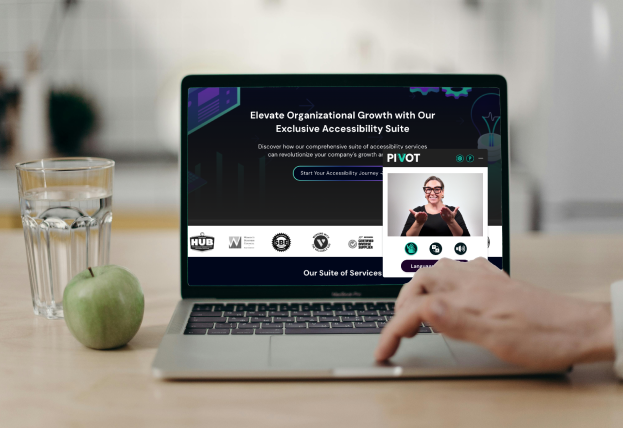The digital landscape is evolving rapidly, and with it, the expectations for both accessibility and aesthetics. For ERG leaders, Accessibility Coordinators, and forward-thinking HR professionals, merging these seemingly competing priorities can feel like an insurmountable challenge. Yet at the intersection of inclusive design and visual appeal lies an opportunity to create digital experiences that genuinely welcome everyone—without sacrificing beauty.
Beyond Compliance—The New Accessibility Paradigm
Accessibility has moved beyond mere compliance checkboxes. Today’s most successful digital experiences demonstrate that inclusive design principles can enhance creativity rather than constrain it. When we design with all users in mind from the beginning, we create products that are not only more usable but also more elegant in their simplicity and thoughtfulness.
The Aesthetic-Accessibility Connection
Research from the Nielsen Norman Group reveals a fascinating phenomenon: designs that prioritize accessibility often score higher in user satisfaction across all demographics—not just among users with disabilities. This “curb-cut effect” demonstrates how solutions originally intended for one group often benefit everyone.
The same principles that make digital products accessible—clarity, consistency, and thoughtful interaction—also make them more aesthetically pleasing and easier to use.
Five Beautiful Accessibility Principles
Let’s explore how specific accessibility best practices can elevate the overall user experience while maintaining visual sophistication.
1. Embrace Minimalism with Purpose
Best Practice:
Streamline interfaces to reduce cognitive load while maintaining essential functionality.
How It Enhances Design:
A clean, minimal interface isn’t just easier for users with cognitive disabilities to navigate—it creates a sense of elegance and sophistication that appeals to all users. Companies like Apple have built their design reputation on this principle, proving that simplicity and beauty go hand in hand.
Implementation Tip:
Focus on progressive disclosure—revealing information only when needed—to create clean interfaces that don’t overwhelm users while maintaining visual harmony.
2. Design a Thoughtful Type System
Best Practice:
Create a typography system with clear hierarchies, sufficient sizing, and optimal line length and spacing.
How It Enhances Design:
Typography is the foundation of both accessible and beautiful design. When you select fonts and establish text styles that prioritize readability, you’re also creating visual rhythm and structure that enhances overall aesthetic appeal.
Implementation Tip:
Choose no more than 2-3 font families with strong distinction between weights. Establish a clear hierarchy with at least 3 heading levels and ensure body text is at least 16px with line height of 1.5.
3. Craft Meaningful Animations
Best Practice:
Use animations purposefully to guide attention and provide feedback while respecting vestibular disorders and user preferences.
How It Enhances Design:
Thoughtful animation adds polish and dimensionality to interfaces. When implemented with accessibility in mind—including respect for reduced motion preferences—animations can enhance usability while creating moments of delight.
Implementation Tip:
Limit animations to 400-500 ms for optimal balance between noticeable movement and performance. Always provide a preferred-reduced-motion alternative and ensure animations support user actions rather than distract from them.
4. Build Inclusive Color Systems
Best Practice:
Create color palettes that meet contrast requirements while expressing brand personality.
How It Enhances Design:
High-contrast color schemes don’t have to be limited to black and white. Strategic use of color creates visual interest while ensuring readability. Brands like Spotify demonstrate how accessibility and vibrant brand expression can coexist beautifully.
Implementation Tip:
Design color systems in complete pairs (background + foreground) that meet WCAG 2.1 AA standards. Use secondary visual cues alongside color to ensure information is perceivable by everyone.
5. Focus on Feedback and Affordance
Best Practice:
Create clear interactive states that provide consistent feedback across all input methods.
How It Enhances Design:
Well-designed focus states, hover effects, and active states don’t just help keyboard users—they add polish and responsiveness that makes interfaces feel more premium and thoughtfully crafted.
Implementation Tip:
Design focus states that align with your visual language rather than relying on browser defaults. Use subtle transitions and multiple visual cues to indicate interactivity.
Case Study: Inclusive Design in Action
When Airbnb redesigned their platform in 2017, they embraced what they called “universal design”—an approach ensuring everyone could use their service regardless of ability or context. The results were striking:
- Booking completion rates improved by 13.6% across all users
- Screen reader navigation time decreased by over 50%
- User satisfaction scores increased among both disabled and non-disabled users
Their redesign featured clear typography, generous touch targets, and thoughtful feedback mechanisms—all wrapped in their signature clean, appealing aesthetic. This demonstrates how accessibility can enhance rather than detract from design quality.
Starting Your Beautiful Accessibility Journey
For organizations looking to elevate both the inclusivity and aesthetic quality of their digital experiences, begin with these practical steps:
1. Audit with Fresh Eyes
Conduct an accessibility audit that looks beyond compliance to consider the overall user experience. Evaluate how accessibility improvements might enhance visual coherence and usability for everyone.
2. Establish Universal Design Principles
Create a set of inclusive design principles specific to your organization that emphasize both accessibility and aesthetics. These should guide all digital products and serve as criteria for evaluating new designs.
3. Involve Diverse Users Early
Include people with disabilities in your design process from the beginning—not just for testing. Their insights often lead to innovative solutions that benefit all users.
4. Build an Accessible Component Library
Develop a system of pre-built, accessible components that designers can use confidently. This ensures consistency while allowing creativity to flourish within an accessible framework.
5. Celebrate Inclusive Design Wins
Recognize and share successes where accessibility and aesthetics come together beautifully. This helps shift organizational culture toward seeing accessibility as an enhancement rather than a constraint.
The Competitive Advantage of Beautiful Accessibility
Organizations that embrace the harmony between accessibility and aesthetics gain significant advantages:
- Expanded market reach to the 1+ billion people worldwide with disabilities
- Improved user engagement and conversion rates across all demographics
- Enhanced brand perception as thoughtful, innovative, and inclusive
- Reduced maintenance costs through consistent implementation
- Protection from potential legal issues related to digital accessibility
Bringing It All Together
As you navigate your accessibility journey, remember that you don’t have to choose between beautiful design and inclusive experiences. With the right approach, expertise, and commitment, you can create digital products that welcome everyone—and look exceptional doing it.
After all, when design works beautifully for everyone, it just feels right.
Ready to create digital experiences that are both stunning and accessible? accesszanü offers comprehensive accessibility services including audits, training, and implementation support tailored to your organization’s needs. Contact us at hello@accesszanu.com or fill out our contact form to start your journey toward beautiful, inclusive design.
Resources
- Nielsen Norman Group. (2022). Aesthetics and Accessibility: How Visual Design Affects Perceptions of Usability. https://www.nngroup.com/articles/aesthetics-and-accessibility/
- Interaction Design Foundation. (2023). Accessibility: How to Design for All. https://www.interaction-design.org/literature/topics/accessibility
- Shea, S. (2019). Designing for Cognitive Differences. A List Apart. https://alistapart.com/article/designing-for-cognitive-differences/
- Airbnb Design. (2017). Building a More Inclusive Way to Travel. https://airbnb.design/inclusive-travel/
- W3C. (2018). Web Content Accessibility Guidelines (WCAG) 2.1. https://www.w3.org/TR/WCAG21/
- World Health Organization. (2022). World Report on Disability. https://www.who.int/disabilities/world_report/2011/report/en/
- Pew Research Center. (2021). Americans with Disabilities: 2021. https://www.pewresearch.org/fact-tank/2021/09/22/americans-with-disabilities/




